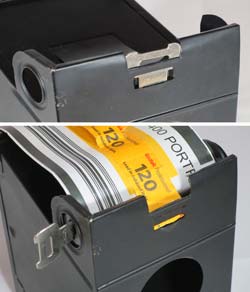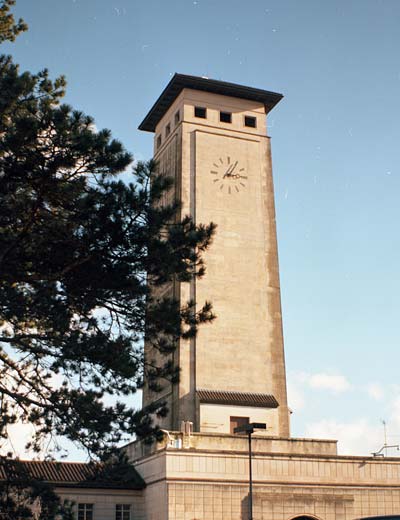Balda Rollbox
Specification

| Manufacturer | : | Balda |
|---|---|---|
| Produced | : | 1935 |
| Classification | : | Medium Format |
| Body Type | : | Box |
| Construction | : | Metal |
| Film Type | : | 120 |
| Film Width | : | 62mm |
| Image Size | : | 2¼ x 3¼ in |
| No. of Images | : | 8 |
| Lens Type | : | Meniscus |
| Focus Type | : | Fixed |
| Focal Length | : | 100mm |
| Focus Range | : | 8ft to inf. |
| Aperture Type | : | Fixed |
| Aperture | : | f/14 |
| Shutter Type | : | Rotary |
| Shutter Speeds | : | B,I*(1/40 sec) |
| Size (w x h x d) | : | 80 x 115 x 127 mm |
| Weight | : | 380g |
| * Measured on this camera | ||
Art Deco Credentials
![]()
![]()
![]()
Noteworthy: Worth giving special attention
- Produced during the main Art Deco period;
- Sunburst pattern on front plate;
- Each face embossed with rectangular pattern;
- Left and right sides embossed with 'Balda' in Art Deco font;
- Chrome decal with camera name on front;
- Chrome border around the front;
- Chrome circles around lens and viewfinders.
- Grooved leather strap;
- Bright metal winder.
Description

The Balda Rollbox II was the successor of the 1932 Rollbox which was a very plain camera with very little adornment. However, the Rollbox II has a chrome plated decal on the front with the name "Balda ROLLBOX" on it. The covering on the front is embossed with a 'sunburst' pattern. Each face of the box has a rectangular pattern embossed into the leatherette. The left and right sides of the camera have the name 'Balda' embossed in the leatherette. The box is made of pressed metal which is lined and lacquered in black. Two tripod sockets are provided for landscape and portrait views. It has a real leather handle with parallel grooves on it. The chrome finishing touches to the front of the camera make this a very handsome piece.
The lens is a simple meniscus with an aperture of f/14. The shutter is a double acting rotary, so the shutter button returns to its resting position (upwards) once released, without causing double exposure. A pull-out tab above the shutter release enables you to select Instantaneous or Timed(bulb) mode. The speed of the shutter on this camera was measured as 1/40 sec. It has a connection socket for cable release. It has an s-shaped knob to wind the film and the film is advanced from frame to frame using the red window.
A fairly unique feature of this camera is the provision of a special key to aid the loading of the film. The key is held in a slot to avoid losing it. It is used to advance and secure the film onto the spool before inserting the film carrier into the camera. Rather neat I think.
How to Use
This camera takes 120 film which is easily available.
As the shutter speed is only 1/40s, it is advisable to use a tripod to get clear shake free images. However, holding it against a wall or other solid object would work as well. For quick snapshots, hold it firmly against your body.
If you don't want to bother with an exposure meter, follow the guide shown. It is based on the 'Sunny 16' rule. Film is so forgiving and will produce acceptable results even when overexposed by 2 or 3 stops or underexposed by 1 stop.
The tables assume that the sun is at least 30 degrees above the horizon - that's 10am - 5pm on a summers day (May - August) in the UK.
Remember that the exposure guide in the manual may not be helpful as it is based on the use of old film with a low ISO value.
Using ISO 100/125 film - shutter speed 1/40s
| Weather Conditions | Shadow Detail | Aperture | Exposure |
|---|---|---|---|
 Sunny SunnySnow/Sand | Dark with sharp edges | f/14 | +2 Stops Overexposed Acceptable |
 Sunny Sunny | Distinct | f/14 | +1 Stop Overexposed Acceptable |
 Slight Overcast Slight Overcast | Soft around edges | f/14 | Good |
 Overcast Overcast | Barely visible | f/14 | -1 Stop Underexposed Acceptable |
 Heavy Overcast Heavy Overcast | None | f/14 | -2 Stops Underexposed Not Acceptable |
 Open Shade Open Shade/Sunset | None | f/14 | -3 Stops Underexposed Not Acceptable |
Photographs taken with this Camera
Kodak Portra 160 film



